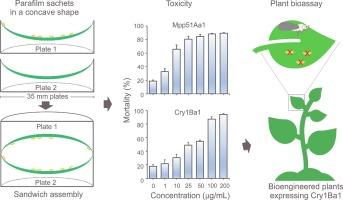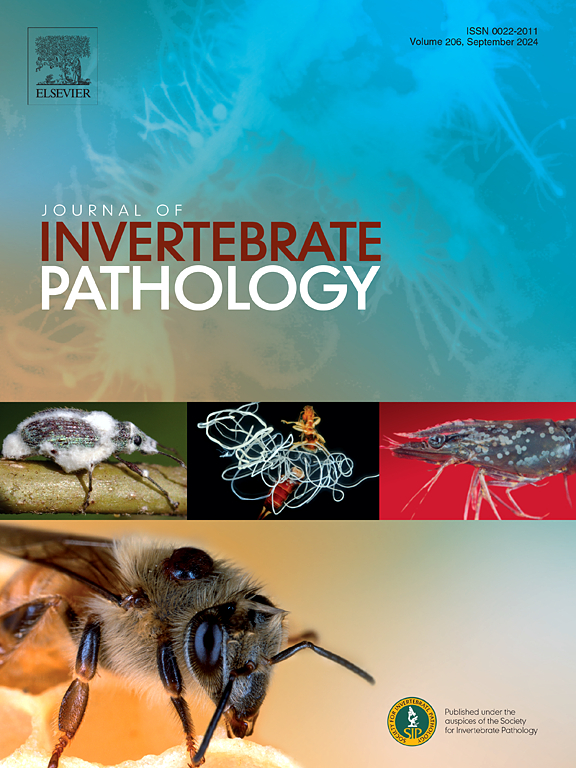The sandwich feeding assay for use with first instar nymphs of the Asian citrus psyllid, Diaphorina citri confirms the high susceptibility of this life stage to bacterial pesticidal proteins
IF 2.4
3区 生物学
Q1 ZOOLOGY
引用次数: 0
Abstract
Citrus greening or huanglongbing is the most important disease of citrus and threatens citrus production worldwide. As nymphs of Diaphorina citri play a crucial role in the acquisition and transmission of the citrus greening bacterium, suppression of this life stage is particularly important. However, the lack of a tractable feeding assay for use with first instar D. citri nymphs has impeded assessment of the toxicity of bioactives. Of several bacterial pesticidal proteins (BPP) that are toxic to D. citri adults, Mpp51Aa1 and Cry1Ba1, which have LC50 values of 110 and 120 µg/mL respectively in adults, were fed to 1st instar nymphs in a newly developed assay. For this new sandwich feeding assay, parafilm layers containing feeding solution were placed on top of two 35 mm Petri dishes, with a concave surface created on each. Fifty nymphs were transferred to the membrane on one Petri dish, and the second Petri dish placed on the top to create a “sandwich” with the 1st instar nymphs in the middle. Nymphs were fed for four days and the LC50 values for Mpp51Aa1 and Cry1Ba1 were calculated at 6.7 and 41.6 µg/mL respectively. Bioassays with bioengineered plants expressing Cry1Ba1 confirmed that the majority of D. citri mortality occurs during the 1st instar nymph stage, while egg laying adults are much less susceptible. Taken together, these results confirm that 1st instar D. citri nymphs are more susceptible to BPP than adults and demonstrate the utility of the sandwich feeding assay for effective screening of BPPs prior to investment into production of transgenic plants.

用于亚洲柑橘木虱(Diaphorina citri)初龄若虫的夹心取食试验证实了这一生命阶段对细菌杀虫蛋白的高度敏感性
柑橘绿化或黄龙病是柑橘最重要的病害,威胁着全世界的柑橘生产。由于柑橘褐斑病若虫在柑橘绿化病菌的获取和传播过程中起着至关重要的作用,因此对这一生命阶段的抑制尤为重要。然而,由于缺乏可用于柑橘褐斑病初生若虫的喂食试验,因此阻碍了对生物活性物质毒性的评估。在几种对 D. citri 成虫有毒的细菌杀虫蛋白(BPP)中,Mpp51Aa1 和 Cry1Ba1 对成虫的半数致死浓度分别为 110 和 120 µg/mL,在一种新开发的试验中,将这两种蛋白喂给初生若虫。在这种新的夹心喂养试验中,将含有喂养液的薄膜层放在两个 35 毫米培养皿的顶部,每个培养皿上都有一个凹面。将 50 只若虫转移到其中一个培养皿的薄膜上,然后将第二个培养皿放在上面,形成一个 "三明治",将第一龄若虫放在中间。若虫喂养四天,计算出 Mpp51Aa1 和 Cry1Ba1 的半数致死浓度分别为 6.7 和 41.6 微克/毫升。用表达 Cry1Ba1 的生物工程植物进行的生物测定证实,大部分柠檬蝇的死亡发生在第一龄若虫阶段,而产卵成虫的易感性要低得多。总之,这些结果证实,柠条幼虫比成虫更容易受到 BPP 的影响,并证明了夹心饲喂试验在投资生产转基因植物之前有效筛选 BPP 的实用性。
本文章由计算机程序翻译,如有差异,请以英文原文为准。
求助全文
约1分钟内获得全文
求助全文
来源期刊
CiteScore
6.10
自引率
5.90%
发文量
94
审稿时长
1 months
期刊介绍:
The Journal of Invertebrate Pathology presents original research articles and notes on the induction and pathogenesis of diseases of invertebrates, including the suppression of diseases in beneficial species, and the use of diseases in controlling undesirable species. In addition, the journal publishes the results of physiological, morphological, genetic, immunological and ecological studies as related to the etiologic agents of diseases of invertebrates.
The Journal of Invertebrate Pathology is the adopted journal of the Society for Invertebrate Pathology, and is available to SIP members at a special reduced price.

 求助内容:
求助内容: 应助结果提醒方式:
应助结果提醒方式:


